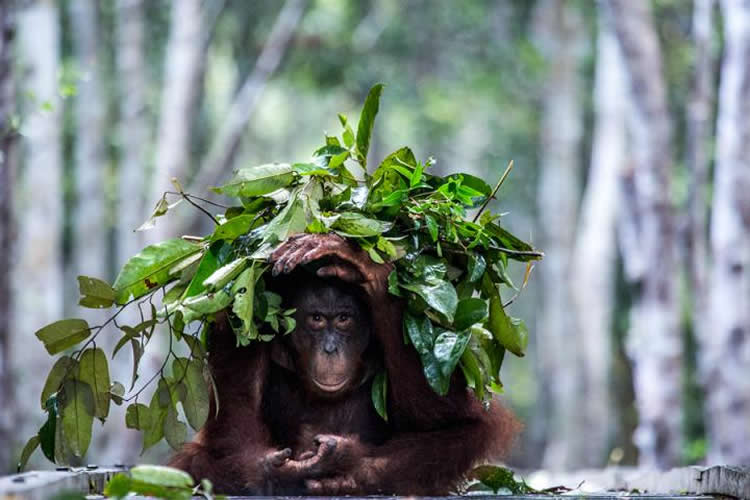Summary: A new associative learning model may help explain animal behavior and intelligence.
Source: Stockholm University.
The fact that animals can use tools, have self-control and certain expectations of life can be explained with the help of a new learning model for animal behaviour. Researchers at Stockholm University and Brooklyn College have combined knowledge from the fields of artificial intelligence, ethology and the psychology of learning to solve several problems concerning the behaviour and intelligence of animals.
Animals are often very effective; an oystercatcher opens mussels quickly, a baboon takes every opportunity to steal food from tourists or a rat navigates with ease between the bins in a park. Previously these behaviours have been considered to be inherited instincts, even though it is well known that animals have great learning abilities. Researchers from Stockholm University and Brooklyn College have now created an associative learning model that explains how effective behaviours can arise. This means that an animal does not only learn that the last step of a behaviour chain, the one that is rewarding, is valuable. An animal can learn that all steps towards the reward are valuable.
“Our learning model may also explain how advanced behaviours are created at an individual level. Behaviours like self-control, chimpanzee tool use as well as other phenomena like animals having certain expectations of live”, says Magnus Enquist, professor of ethology at Stockholm University. “Similar models are used in the field of artificial intelligence, but they have been ignored in animal studies.”

Since the 1970s it has been known that animals weigh the cost of a certain behaviour against the profit and that they, to a high degree, make optimal decisions, which is assumed to be genetically determined. The research group’s new model deals not only with learning, it also takes into account the idea that what animals are able to learn can be genetically regulated.
“Young animals are often a bit clumsy, while adult animals are extremely skilled. A small cub does not even consider a vole as food, while an adult fox is an expert vole catcher”, says Johan Lind associate professor of ethology at Stockholm University. “Our model shows how genetic regulation of learning can influence the development of species-specific behaviour and intelligence since evolution can affect curiosity and the speed of learning among other things.”
The researchers’ new model could also explain counterproductive behaviour in artificial environments.
“Many learning models can explain optimal behaviour, but to explain counterproductive behaviour an understanding of the mechanisms of the behaviour is needed. Using our model, we manage to explain why animals get stuck in suboptimal behaviour. Like a hamster running in its hamster wheel despite having food next to it. Our model has captured fundamental aspects of learning”, says Stefano Ghirlanda, professor of psychology at Brooklyn College in New York.
The learning model and the research results were recently published in the journal Royal Society Open Science.
This research is part of the project From Nature to Culture, funded by the Knut and Alice Wallenberg Foundation.
Source: Magnus Enquist – Stockholm University
Image Source: NeuroscienceNews.com image is credited to Johan Lind/N.
Original Research: Full open access research for “The power of associative learning and the ontogeny of optimal behaviour” by Magnus Enquist, Johan Lind, and Stefano Ghirlanda in Royal Society Open Science. Published online November 30 2016 doi:10.1098/rsos.160734
[cbtabs][cbtab title=”MLA”]Stockholm University “Learning Makes Animals Intelligent.” NeuroscienceNews. NeuroscienceNews, 1 December 2016.
<https://neurosciencenews.com/learning-intelligence-animals-5655/>.[/cbtab][cbtab title=”APA”]Stockholm University (2016, December 1). Learning Makes Animals Intelligent. NeuroscienceNew. Retrieved December 1, 2016 from https://neurosciencenews.com/learning-intelligence-animals-5655/[/cbtab][cbtab title=”Chicago”]Stockholm University “Learning Makes Animals Intelligent.” https://neurosciencenews.com/learning-intelligence-animals-5655/ (accessed December 1, 2016).[/cbtab][/cbtabs]
Abstract
The power of associative learning and the ontogeny of optimal behaviour
Behaving efficiently (optimally or near-optimally) is central to animals’ adaptation to their environment. Much evolutionary biology assumes, implicitly or explicitly, that optimal behavioural strategies are genetically inherited, yet the behaviour of many animals depends crucially on learning. The question of how learning contributes to optimal behaviour is largely open. Here we propose an associative learning model that can learn optimal behaviour in a wide variety of ecologically relevant circumstances. The model learns through chaining, a term introduced by Skinner to indicate learning of behaviour sequences by linking together shorter sequences or single behaviours. Our model formalizes the concept of conditioned reinforcement (the learning process that underlies chaining) and is closely related to optimization algorithms from machine learning. Our analysis dispels the common belief that associative learning is too limited to produce ‘intelligent’ behaviour such as tool use, social learning, self-control or expectations of the future. Furthermore, the model readily accounts for both instinctual and learned aspects of behaviour, clarifying how genetic evolution and individual learning complement each other, and bridging a long-standing divide between ethology and psychology. We conclude that associative learning, supported by genetic predispositions and including the oft-neglected phenomenon of conditioned reinforcement, may suffice to explain the ontogeny of optimal behaviour in most, if not all, non-human animals. Our results establish associative learning as a more powerful optimizing mechanism than acknowledged by current opinion.
“The power of associative learning and the ontogeny of optimal behaviour” by Magnus Enquist, Johan Lind, and Stefano Ghirlanda in Royal Society Open Science. Published online November 30 2016 doi:10.1098/rsos.160734






